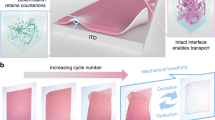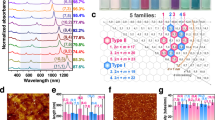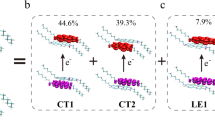Abstract
A two-terminal semiconducting single-walled carbon nanotube (SC-SWNT) film in contact with an ionic liquid allows the realization of an extremely high density of holes, inducing a strong position-dependent electromodulation of the interband and excitonic transitions as a result of the position-dependent shift of the SWNT Fermi level. Electrical control of the optical transmission suggests applications of the SC-SWNT thin films as electrically configurable optical media, while the wide spectral range of the electro-optical modulation, which extends from the far-infrared to the visible, provides a viable approach to large-area electrochromic smart windows.
This is a preview of subscription content, access via your institution
Access options
Subscribe to this journal
Receive 12 print issues and online access
$209.00 per year
only $17.42 per issue
Buy this article
- Purchase on Springer Link
- Instant access to full article PDF
Prices may be subject to local taxes which are calculated during checkout





Similar content being viewed by others
References
Dresselhaus, M. S., Dresselhaus, G. & Avouris, P. Carbon Nanotubes: Synthesis, Structure, Properties and Applications (Springer-Verlag, 2001).
Dresselhaus, M. S., Dresselhaus, G. & Jorio, A. Carbon Nanotubes: Advanced Topics in the Synthesis, Structure, Properties and Applications (Springer-Verlag, 2008).
Avouris, P., Freitag, M. & Perebeinos, V. Carbon-nanotube photonics and optoelectronics. Nature Photon. 2, 341–350 (2008).
Freitag, M., Martin, Y., Misewich, J. A., Martel, R. & Avouris, P. Photoconductivity of single carbon nanotubes. Nano Lett. 3, 1067–1071 (2003).
Levitsky, I. A. & Euler, W. B. Photoconductivity of single-wall carbon nanotubes under continuous-wave near-infrared illumination. Appl. Phys. Lett. 83, 1857–1859 (2003).
Freitag, M. et al. Hot carrier electroluminescence from a single carbon nanotube. Nano Lett. 4, 1063–1066 (2004).
Itkis, M. E., Borondics, F., Yu, A. & Haddon, R. C. Bolometric infrared photoresponse of suspended single-walled carbon nanotube films. Science 312, 413–416 (2006).
Tarasov, M., Svensson, J., Weis, J., Kuzmin, L. & Campbell, E. Carbon nanotube based bolometer. JETP Lett. 84, 267–270 (2006).
Lee, J. U., Codella, P. J. & Pietrzykowski, M. Direct probe of excitonic and continuum transitions in the photocurrent spectroscopy of individual carbon nanotube p–n diodes. Appl. Phys. Lett. 90, 053103 (2007).
Mann, D. et al. Electrically driven thermal light emission from individual single-walled carbon nanotubes. Nature Nanotech. 2, 33–38 (2007).
Itkis, M. E., Yu, A. & Haddon, R. C. Single-walled carbon nanotube thin film emitter–detector integrated optoelectronic device. Nano Lett. 8, 2224–2228 (2008).
St-Antoine, B. C., Menard, D. & Martel, R. Single-walled carbon nanotube thermopile for broadband light detection. Nano Lett. 11, 609–613 (2011).
Wu, Z. et al. Transparent, conductive carbon nanotube films. Science 305, 1273–1276 (2004).
Gruner, G. Carbon nanotube films for transparent and plastic electronics. J. Mater. Chem. 16, 3533–3539 (2006).
Zhang, D. et al. Transparent, conductive, and flexible carbon nanotube films and their applications in organic light-emitting diodes. Nano Lett. 6, 1880–1886 (2006).
Zhang, M. et al. Strong, transparent, multifunctional, carbon nanotube sheets. Science 309, 1215–1219 (2005).
Kaempgen, M., Duesberg, G. S. & Roth, S. Transparent carbon nanotube coating. Appl. Surf. Sci. 252, 425–429 (2005).
Kavan, L. et al. Electrochemical tuning of electronic structure of single-walled carbon nanotubes: in-situ Raman and vis-NIR studies. J. Phys. Chem. B 105, 10764–10771 (2001).
Zukalova, M., Tarabek, J., Kalbac, M., Kavan, L. & Dunsch, L. In situ optical spectroelectrochemistry of single-walled carbon nanotube thin films. J. Solid State Electrochem. 12, 1279–1284 (2008).
Wang, F., Itkis, M. E. & Haddon, R. C. Enhanced electromodulation of infrared transmittance in semitransparent films of large diameter semiconducting single-walled carbon nanotubes. Nano Lett. 10, 937–942 (2010).
Perebeinos, V. & Avouris, P. Exciton ionization, Frank–Keldysh, and Stark effects in carbon nanotubes. Nano Lett. 7, 609–613 (2007).
Takenobu, T., Murayama, Y. & Iwasa, Y. Optical evidence of Stark effect in single-walled carbon nanotube transistors. Appl. Phys. Lett. 89, 263510 (2006).
Takenobu, T., Murayama, Y., Shiraishi, M. & Iwasa, Y. Optical observation of carrier accumulation in single-walled carbon nanotube transistors. Jpn J. Appl. Phys. 45, L1190–L1192 (2006).
Ham, M. H., Kong, B. S., Kim, W. J., Jung, H. T. & Strano, M. S. Unusually large Franz–Keldysh oscillations at ultraviolet wavelengths in single-walled carbon nanotubes. Phys. Rev. Lett. 102, 047402 (2009).
Granqvist, C. G. Electrochromic materials: out of a niche. Nature Mater. 5, 89–90 (2006).
Baetens, R., Jelle, B. P. & Gustavsen, A. Properties, requirements and possibilities of smart windows for dynamic daylight and solar energy control in buildings: a state-of-the-art review. Solar Ener. Mater. Solar Cells 94, 87–105 (2010).
Granqvist, C. G. Oxide electrochromics: an introduction to devices and materials. Solar Ener. Mater. Solar Cells 99, 1–13 (2012).
Jaksic, N. I. & Salahifar, C. A feasibility study of electrochromic windows in vehicles. Solar Ener. Mater. Solar Cells 79, 409–423 (2003).
Chen, J. et al. Solution properties of single-walled carbon nanotubes. Science 282, 95–98 (1998).
Matsunaga, R., Matsuda, K. & Kanemitsu, Y. Observation of charged excitons in hole-doped carbon nanotubes using photoluminescence and absorption spectroscopy. Phys. Rev. Lett. 106, 037404 (2011).
McEuen, P. L. & Park, J-Y. Electron transport in single-walled carbon nanotubes. MRS Bull. 29, 272–275 (2004).
Yaish, Y. et al. Electrical nanoprobing of semiconducting carbon nanotubes using an atomic force microscope. Phys. Rev. Lett. 92, 046401 (2004).
Kang, D. et al. Adsorption-induced conversion of the carbon nanotube field effect transistor from ambipolar to unipolar behavior. Appl. Phys. Lett. 86, 093105 (2005).
Nosho, Y., Ohno, Y., Kishimoto, S. & Mizutani, T. Relation between conduction property and work function of contact metal in carbon nanotube field-effect transistors. Nanotechnology 17, 3412–3415 (2006).
Chai, Y. et al. Low-resistance electrical contacts to carbon nanotubes with graphite interfacial layer. IEEE Trans. Electron. Dev. 59, 12–19 (2012).
Ye, J. T. et al. Liquid-gated interface superconductivity on an atomically flat film. Nature Mater. 9, 125–128 (2010).
Ueno, K. et al. Electric-field-induced superconductivity in an insulator. Nature Mater. 7, 855–858 (2008).
Ueno, K. et al. Discovery of superconductivity in KTaO3 by electrostatic carrier doping. Nature Nanotech. 6, 408–412 (2011).
Yuan, H. T. et al. High-density carrier accumulation in ZnO field-effect transistors gated by electric double layers of ionic liquids. Adv. Funct. Mater. 19, 1046–1053 (2009).
Yuan, H. T. et al. Liquid-gated ambipolar transport in ultrathin films of a topological insulator Bi2Te3 . Nano Lett. 11, 2601–2605 (2011).
Ye, J. T. et al. Accessing the transport properties of graphene and its multilayers at high carrier density. Proc. Natl Acad. Sci. USA 108, 13002–13006 (2011).
Acknowledgements
This material is based on research sponsored by the Defense Microelectronics Activity (DMEA) (agreement no. H94003-10-2-1003). The US Government is authorized to reproduce and distribute reprints for Government purposes, notwithstanding any copyright notation thereon.
Author information
Authors and Affiliations
Contributions
F.W., M.E.I. and R.C.H. contributed to the original idea. M.E.I. and R.C.H. supervised the project. F.W. and M.E.I. designed and set up the experiment. F.W. performed the experiment. F.W., M.E.I., E.B. and R.C.H. contributed to the data analysis, interpretation of the results and preparation of the manuscript. M.E.I. and R.C.H. wrote the manuscript.
Corresponding author
Ethics declarations
Competing interests
The authors declare no competing financial interests.
Rights and permissions
About this article
Cite this article
Wang, F., Itkis, M., Bekyarova, E. et al. Charge-compensated, semiconducting single-walled carbon nanotube thin film as an electrically configurable optical medium. Nature Photon 7, 459–465 (2013). https://doi.org/10.1038/nphoton.2013.66
Received:
Accepted:
Published:
Issue Date:
DOI: https://doi.org/10.1038/nphoton.2013.66



